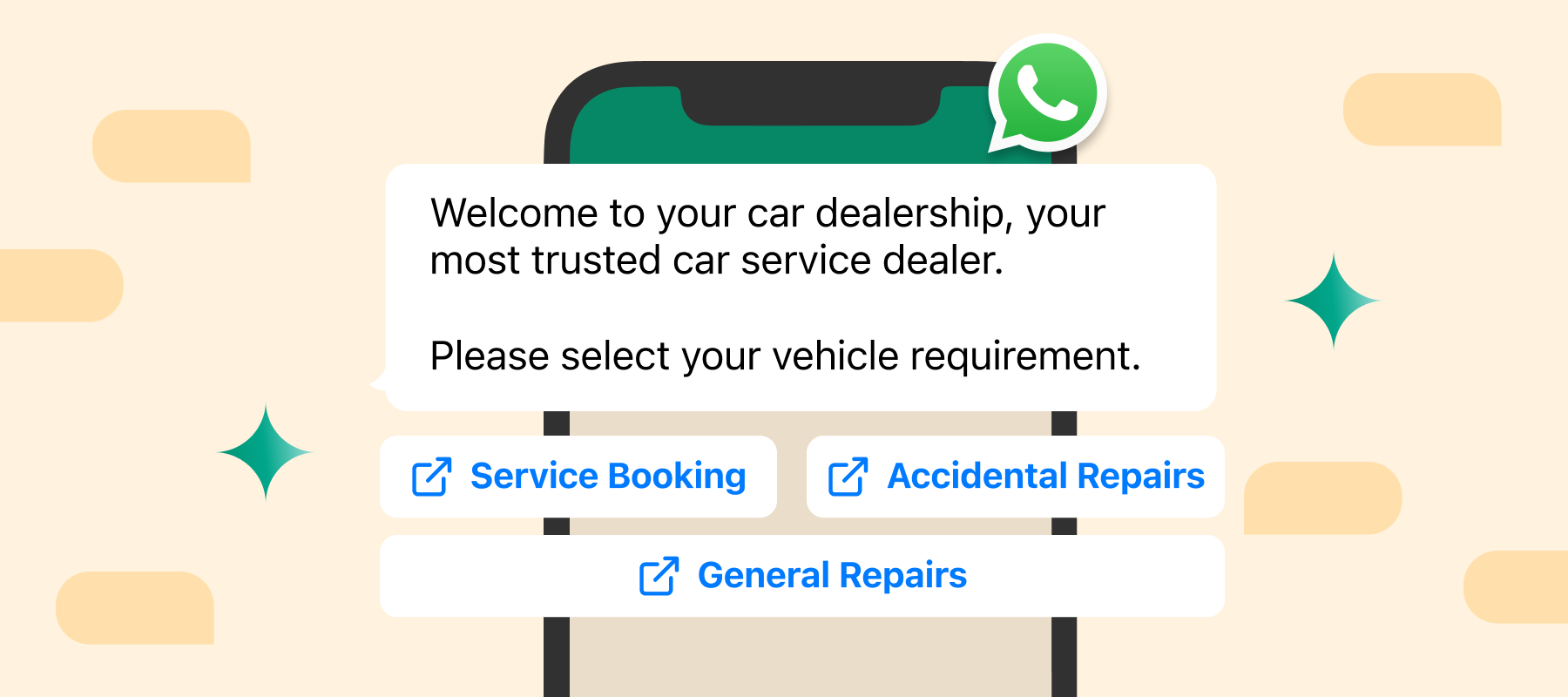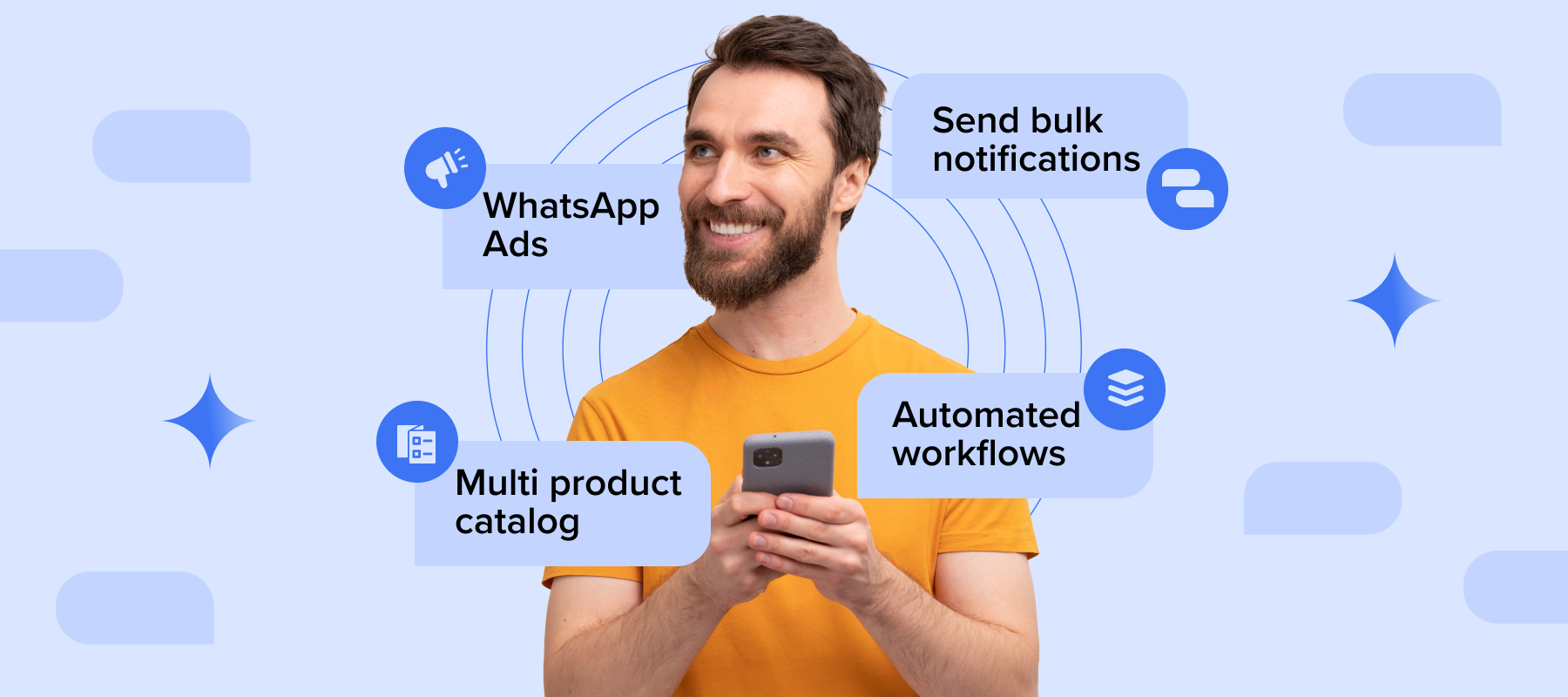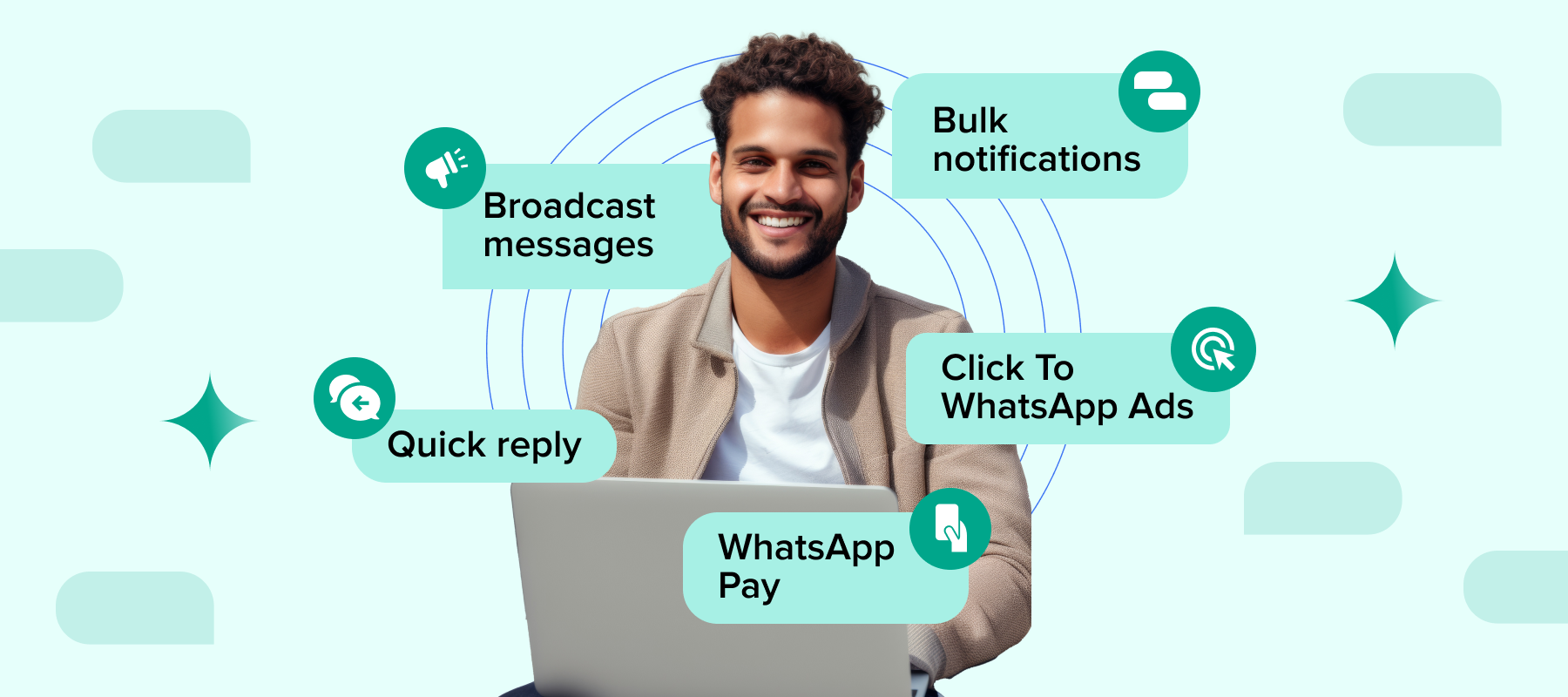Businesses from diverse industries use WhatsApp for communication at scale, and this is proving beneficial for them in a lot of ways.
It is very important for businesses with an online presence to be able to generate data on their leads & qualify them effectively. Moreover, it is crucial to collect data from customers on their preferences & also on their feedback.
WhatsApp is a great medium for doing the above at scale & in an automated and personalised way. ‘Build WhatsApp Flows’ is a feature via which businesses can eliminate the friction involved in such data collection activities.
What are WhatsApp Flows?
WhatsApp Flows are a way to create a customizable & interactive secondary interface within WhatsApp, for businesses to collect responses from customers, instead of collecting those responses in a 2 way chat.
WhatsApp Flows are typically created using decision trees or predefined logic, where each action taken by a user triggers a response.
WhatsApp Flows are capable of doing more than the basic automations, and can offer interactive and structured experiences that can be customized and tailored to individual customer needs. WhatsApp Flows are also capable of collecting valuable customer data on user behavior, which can enable businesses to easily optimize their communication for better results.
It is important to note that there are a few prerequisites for using WhatsApp Flows. This includes:
• A verified WhatsApp Business account.
• WhatsApp Business API account.
• A reliable and effective flow manager like Interakt that can enable you to access and leverage the WhatsApp Business API.
Why WhatsApp Flows are a Game-Changer for Businesses?
WhatsApp Flows empowers businesses to design various interactive experiences, enabling customers to complete tasks more efficiently within the WhatsApp environment. With a range of customizable components, brands can craft tailored journeys that offer highly relevant and seamless interactions for their audience.
One of the standout benefits of WhatsApp Flows is its ability to minimize customer drop-offs. Often, users engage initially but disengage after a few messages, especially when redirected to external links or subjected to lengthy conversations. This creates friction and disrupts the user experience.
Consider a scenario where a customer receives a message about an attractive loyalty program from their favorite salon. The message includes a “sign up” button, but clicking it redirects the customer to a separate browser tab that fails to load properly. This broken journey frustrates the user, resulting in disengagement and lost opportunities for the brand.
With WhatsApp Flows, brands can now create forms directly within the app for various purposes such as sign-ups, appointment scheduling, lead collection, account management, surveys, and more. By keeping the entire process within WhatsApp, businesses ensure a smoother, more cohesive experience, reducing friction and boosting customer satisfaction.
In this post, we will provide a comprehensive guide on WhatsApp Flows, covering everything from its different types of flows on WhatsApp to best practices, to examples, setup, and more.
Benefits of WhatsApp Flows
Flows are mostly used by businesses to meet the demand for engaging and interactive business-customer communication on a familiar and accessible platform like WhatsApp. Some of the major benefits of using WhatsApp Flows include:
Deliver customized insurance quotes on WhatsApp
On WhatsApp different banks can capture customer preferences and provide tailored insurance quotes with flows. This simplifies the process of obtaining insurance quotes, offering customers a fast and personalized experience during the decision-making process.
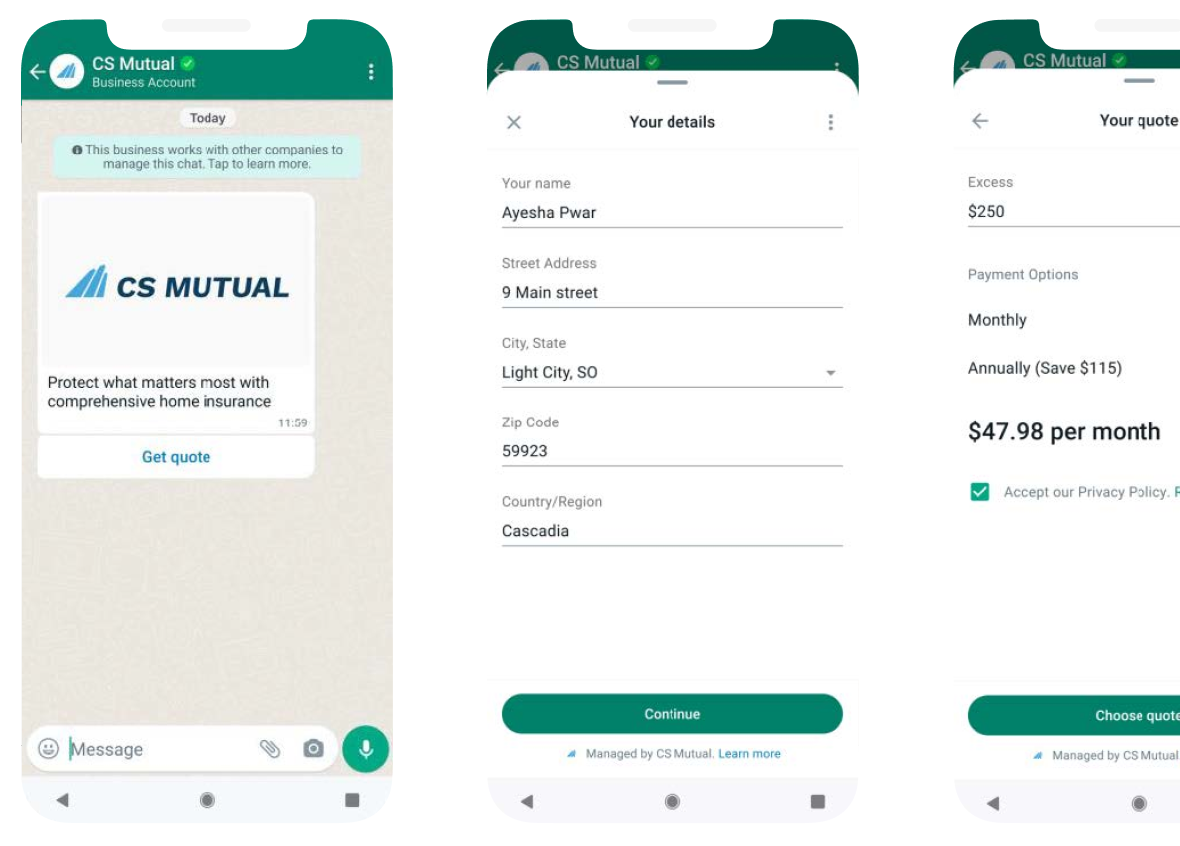
Boost Sales with Tailored Offers on WhatsApp
On WhatsApp business like D2C, ecommerce, hotels and even agencies can capture customer interest through behavior tracking, sending exclusive deals directly to users, providing timely reminders for abandoned carts or promotions, and delivering personalized recommendations based on past interactions.
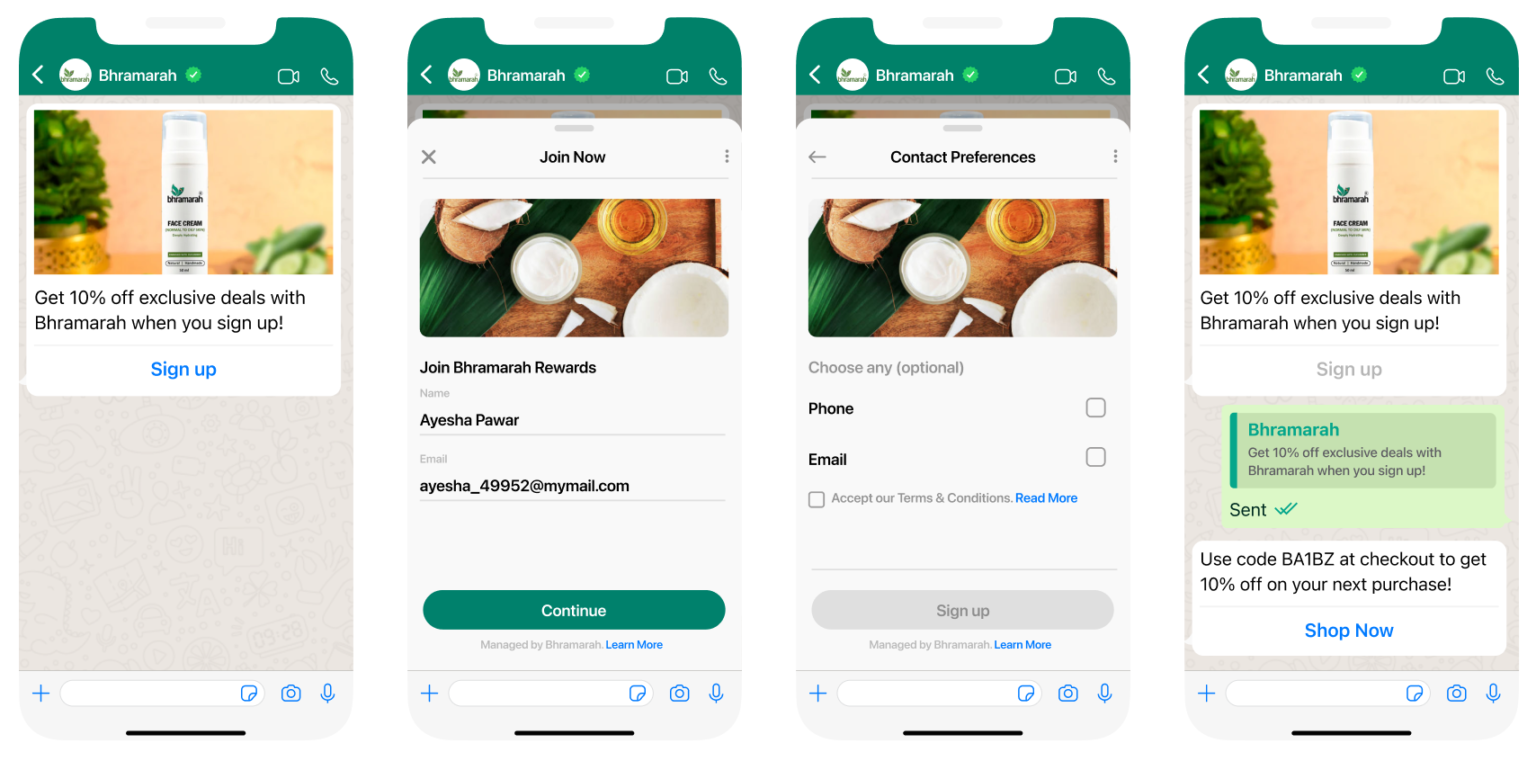
Enhance Guest Experiences with WhatsApp
Hotel & hospitalisty industries can leverage WhatsApp flows for reservation management, giving personalized offers, and timely emergency alerts. Businesses can even streamline customer interactions and enhance loyalty with automated reminders and loyalty program updates.
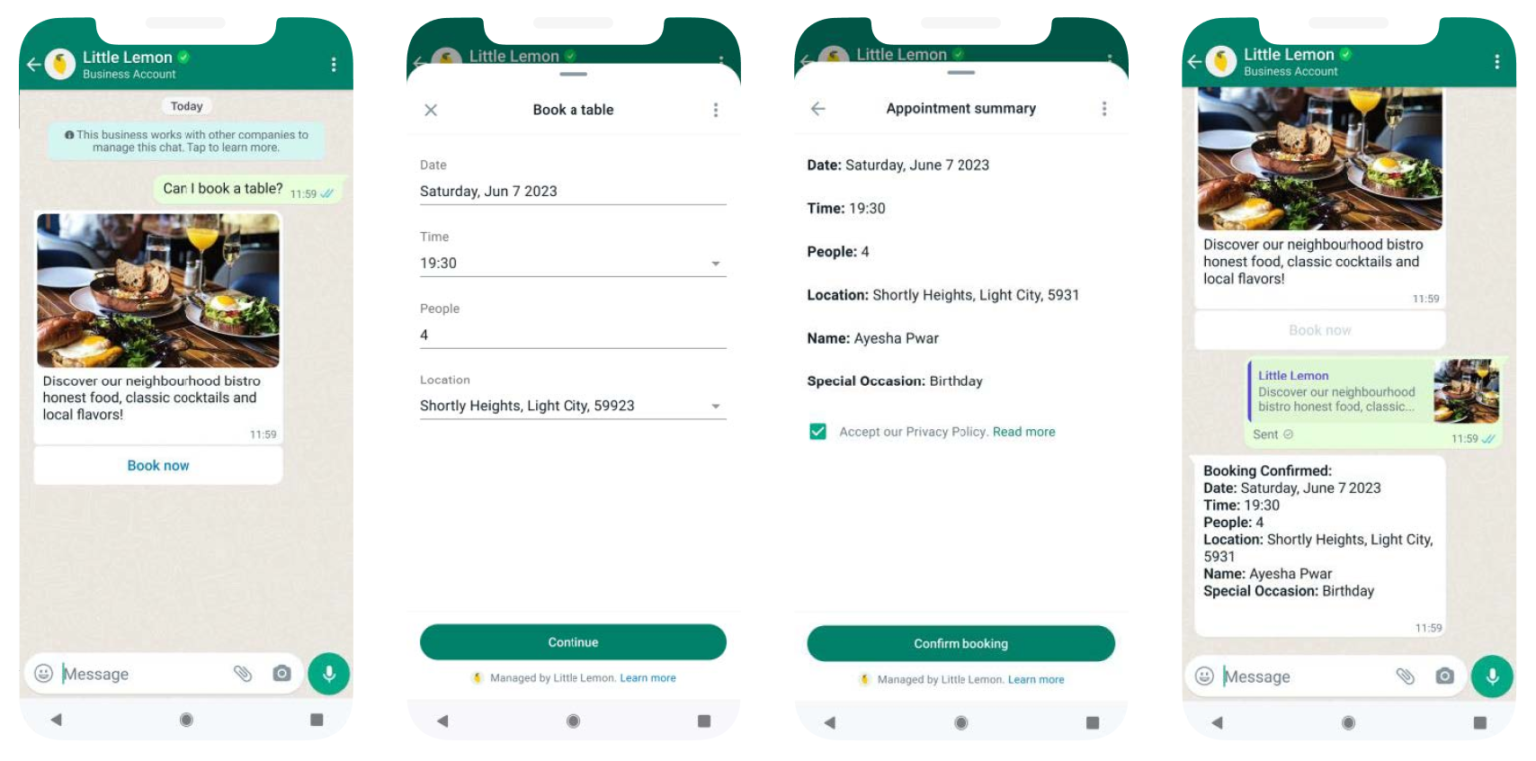
Key features of WhatsApp Flows
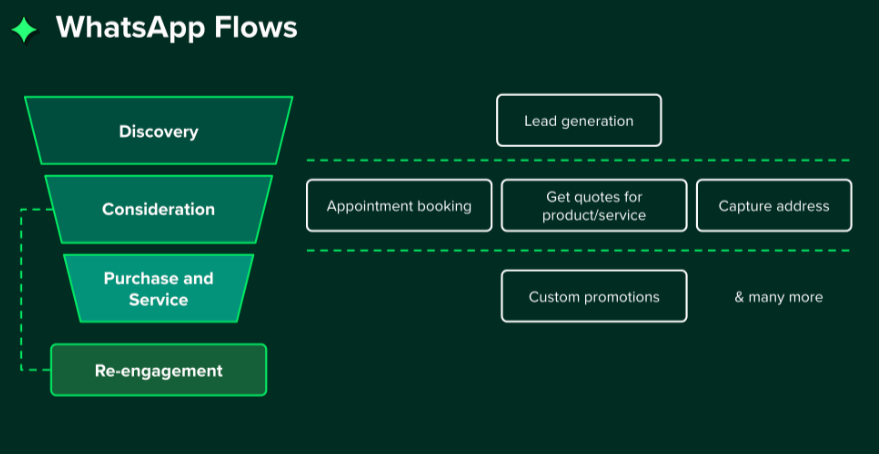
Interactive Workflows
Workflows on WhatsApp are designed to actively engage customers by using various dynamic elements, like buttons, lists, and forms. This gives user a customized experience.
Real-Time Data Exchange
WhatsApp flows can exchange data in real-time to provide personalized and relevant experiences for users. Real-time data exchange on WhatsApp flows allow businesses to adjust messaging based on customer input, such as location, language preferences, or previous interactions.
Seamless Integration
Effortlessly connect WhatsApp Flows with your existing CRM systems, e-commerce platforms, and other essential business tools. This seamless integration allows you to automate workflows, reduce manual tasks, and enhance customer interactions by providing timely and relevant information across all touchpoints.
Personalized Messaging
Leverage customer data to create highly personalized messaging experiences. Using insights such as purchase history, preferences, and behavior, WhatsApp Flows enables you to send tailored messages that resonate with each customer, leading to improved user satisfaction and higher engagement rates.
Real-time Analytics and Insights
Gain valuable insights into your business performance with real-time analytics. Track key metrics such as message delivery rates, customer engagement, and conversion rates. Use this data to continuously optimize your flows, making data-driven decisions to improve customer interactions and achieve better business outcomes.
Scalable Solutions
WhatsApp Flows is built to scale alongside your business. Whether you’re handling a few customer interactions or managing thousands, the platform ensures smooth performance and reliable communication without any compromise on speed or quality, effortlessly accommodating growth and increasing customer demands.
Use Cases of WhatsApp Flows
So far, we have discussed the benefits of WhatsApp Flows and looked at the two major types. But to have a clearer picture of the effectiveness of WhatsApp Flows in the real world, let us look at three examples where it can be applied for positive results:
Appointment booking
WhatsApp Flows can be a great alternative to traditional methods of scheduling appointments online. Businesses can let customers easily check availability, choose convenient time slots, provide details and receive instant confirmation from WhatsApp itself.
WhatsApp Flows can also be configured to effectively handle rescheduling requests and cancellations, which allows the business to provide the flexibility that customers expect from them.
In addition to scheduling appointments and confirming them, WhatsApp Flows can also be used to share automated reminders ahead of the appointment date, to reduce the probability of no-shows.
This results in a smoother, more user-friendly scheduling procedure for customers, which lessens the workload for administrative staff. Here is a good example of a booking confirmation WhatsApp flow message:
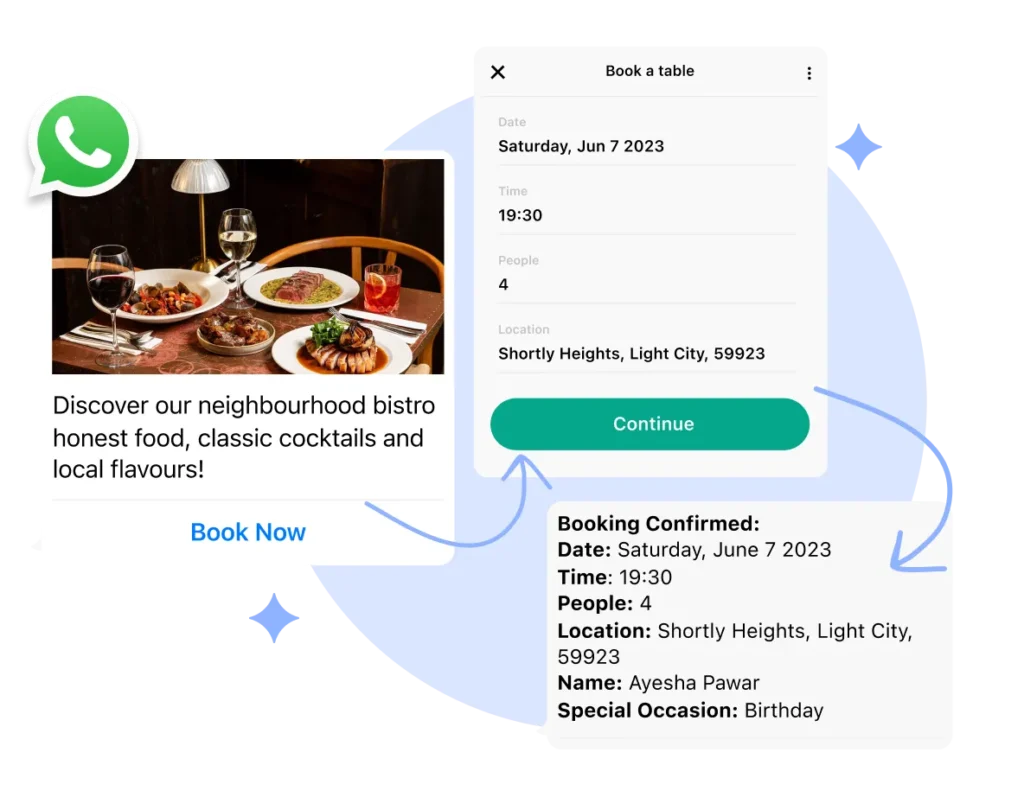
Hey [NAME].
Your booking is confirmed for the date of [DATE] at [TIME], [LOCATION].
Hoping to see you there!
Cheers!
Abandoned cart reminder
Abandoned cart messages are crucial for recovering, otherwise lost sales and WhatsApp Flows can be highly effective in automating this process. If a customer has abandoned products in their shopping cart without completing the purchase, the flow alerts the customer to complete the purchase, with a highly personalized reminder.
These reminders can also include the details of particular products that were left in the cart as well as images and descriptions of the products to reignite the interest of the customer.
This process can be further incentivized as the flow can offer customers discounts or special promotions through reminders to encourage immediate action from them. A direct link to the cart can also be provided which makes it easier for customers to complete the transaction. Here is an example of an abandoned cart recovery WhatsApp Flow message:
In addition to scheduling appointments and confirming them, WhatsApp Flows can also be used to share automated reminders ahead of the appointment date, to reduce the probability of no-shows.
This results in a smoother, more user-friendly scheduling procedure for customers, which lessens the workload for administrative staff. Here is a good example of a booking confirmation WhatsApp flow message:
Hey [NAME].
You left behind [PRODUCT NAME] in your shopping cart!
Get back to it now and get a flat 10% discount at checkout!
Hurry up!”
Loan status
In industries such as finance and banking, transparency is everything. Customers need to be kept informed on loan status as this can make or break the trust they have in the company or financial institution. This is another instance where WhatsApp Flows can be an ideal solution.
Flows can be set up to share updates through WhatsApp, automatically at every stage of the loan process, from the application stage to the final approval.
Besides application tracking, the flow can send timely repayment reminders to ensure that the customers stay on top of their financial obligations. You can also provide customers with instant notifications about loan approval and share further instructions or information on the procedure for receiving the funds.
Here is a WhatsApp flow message example for a loan approval:
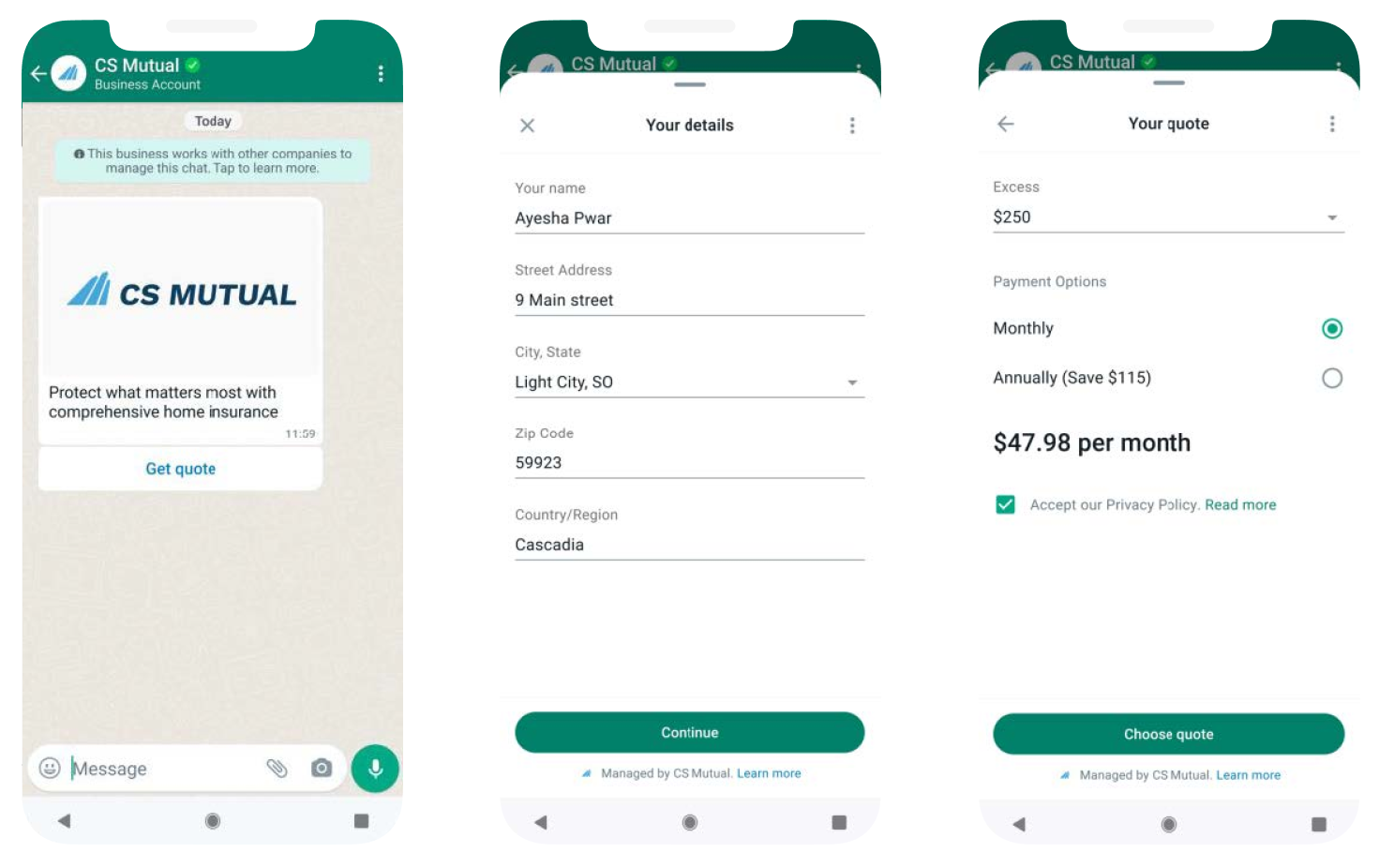
Hey [NAME].
Great news!
Your loan of [AMOUNT] has been approved. Refer to the attached PDF below for more information.
Thank you for banking with us!”
Order Tracking and Updates
In industries like retail and e-commerce, timely updates are crucial. Customers want to know the status of their orders at every stage, from purchase to delivery. WhatsApp Flows provide an excellent solution to automate these updates and keep customers informed in real time.
For instance, a flow can notify customers when their order is confirmed, shipped, or out for delivery. It can also share tracking details and allow customers to ask for support instantly if they have questions. This level of transparency helps build trust and improves the overall shopping experience.
In addition to tracking, WhatsApp Flows can send proactive updates like reminders for payment collection on COD orders or follow-ups on incomplete deliveries. You can also provide instructions or tips for using the purchased product to enhance customer satisfaction.
Hey [NAME],
Your order #12345 has been shipped! 🚚
Track your package here: [Tracking Link]. Estimated delivery: [Date].
Have questions?
Reply here!
Feedback Collection
WhatsApp Flows simplify feedback collection by automating review requests post-purchase. Businesses can ask customers to share their experience or rate the service. Interactive options, like buttons, make it easy for customers to leave reviews, boosting response rates and providing valuable insights for improvement.
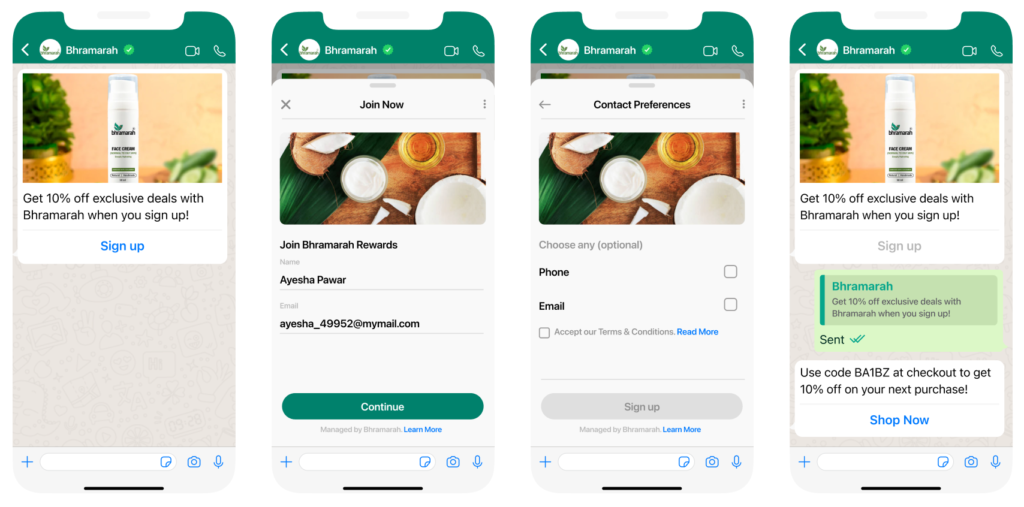
Hey [NAME],
we’d love your feedback on your recent purchase! 🌟 Please rate us here: [Feedback Link].
Your input helps us prove.
Thank you!"
What are the types of WhatsApp Flows?
Knowing the different types of WhatsApp Flows is important to select the right approach that best suits the specific needs and communication goals of your business. WhatsApp Flows can be categorized mainly into two types:
1. WhatsApp Flows without data exchange
WhatsApp Flows without data exchange are mainly focused on delivering static information or for guiding users through a predefined path, without the requirement of any user-specific inputs or personal data from the customer.
These flows are generally used for scenarios that only require straightforward interaction- where user action is limited to choosing options or receiving information.
A few examples of WhatsApp Flows without data exchange are:
– Setup simple customer surveys.
– Collecting data from leads that have come in via a CTWA ad
– Taking registrations for an upcoming event
Some common examples of WhatsApp Flows with data exchange are:
– Appointment booking flow with dynamic appointment slots.
– Insurance application flows with personalized insurance offers at the end
2. WhatsApp Flows with data exchange
WhatsApp Flows with data exchange are dynamic flows that are used in scenarios that require more interactive and personalized communication and will involve the collecting, processing and utilizing of user-specific data or information for the interaction.
These flows are employed when you need to ask questions specific to each user or provide personalized options based on their past interactions and other data.
You must set up an API endpoint for these WhatsApp Flows so that it may deliver dynamic data for each user at different stages of the cycle. WhatsApp will call on this API each time a user goes through the flow.
Though more complex to design, these WhatsApp Flows greatly enhance customer satisfaction and operational efficiency.
Some common examples of WhatsApp Flows with data exchange are:
– Appointment booking flow with dynamic appointment slots.
– Insurance application flows with personalized insurance offers at the end
– Loan application flow with personalized loan offers at the end.
How to build flows on WhatsApp?
To send WhatsApp Flows, you need a Facebook Business Manager account and then create templates on your account using a WhatsApp Business Solution Provider.
Later these flow responses can be tracked through campaign reports, webhooks (soon to be available), or viewed directly in the Interakt inbox.
Steps to create WhatsApp Flows with Interakt
Step 1:
Create WhatsApp Flows in Facebook Business Manager
Step 2:
Create a WhatsApp Flow Template in Interakt
Step 3:
Send the Flow Template via Interakt as WhatsApp Marketing Campaigns or notifications
Step 4:
Monitor Flow Responses
Send a Template with an attached WhatsApp Flow
1. Via Interakt Campaigns
To send a template with flow via Interakt Campaigns, you can simply select the created template and set the campaign live.
(Note – After selecting a ‘template with flow’, you’ll see 2 optional fields named ‘flow_token’ and ‘flow_data’, which should be used, depending on how your flow is created. Note that ‘flow_data’ only accepts json values).
2. Via Interakt APIs
You can send a template with flow via Interakt’s Send Template API.
– If the flow is created such that it doesn’t require any ‘flow_token’ or ‘flow_action_data’, then use a payload like below. Make sure to include the following key-value pair in the payload → “is_flow_template” : true
(note: The below example is for a template with no header, 1 body variable & a flow button. For your particular template, please modify the payload depending upon the presence of headers / variables etc. Follow the Send Template API WhatsApp flows documentation here.)
-data
Where Can You Use WhatsApp Forms?
Merchants on Interakt’s Growth Plan and above can now add WhatsApp Forms to the following auto-replies and workflows:
1. Welcome Message – Capture customer details right from their first interaction.
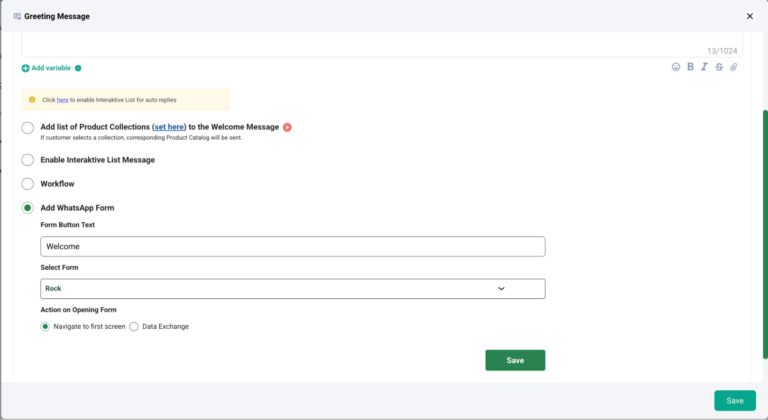
2. Out-of-Office (OOO) Message – Collect inquiries even when you’re unavailable.
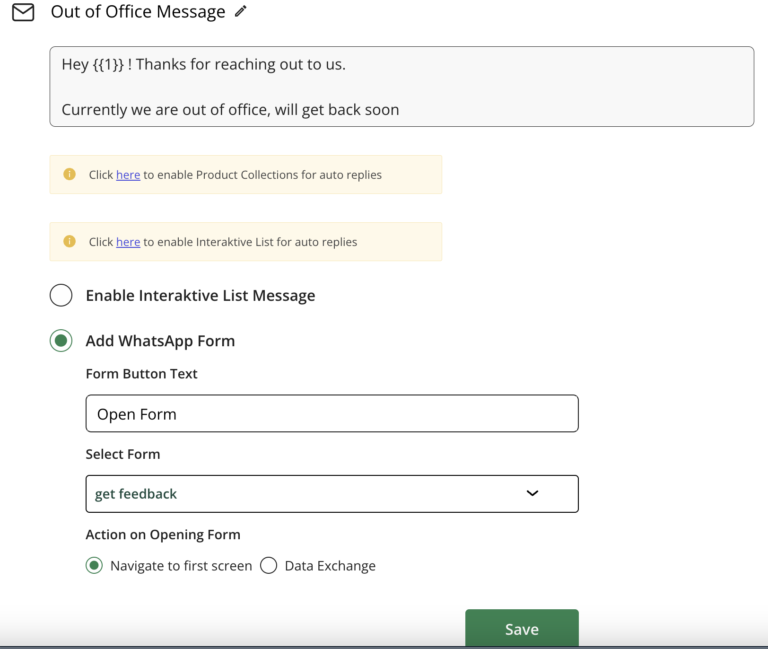
3. Delayed Message – Ensure engagement while waiting for a response.
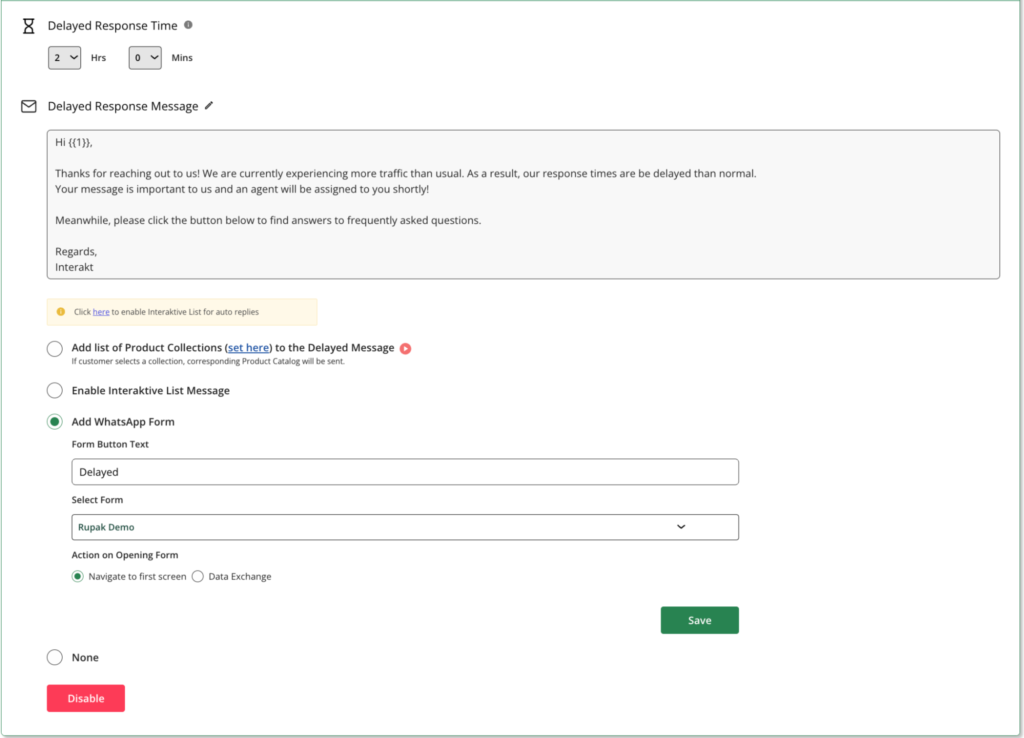
4. Custom Auto Replies – Automate data collection based on specific keywords or triggers.
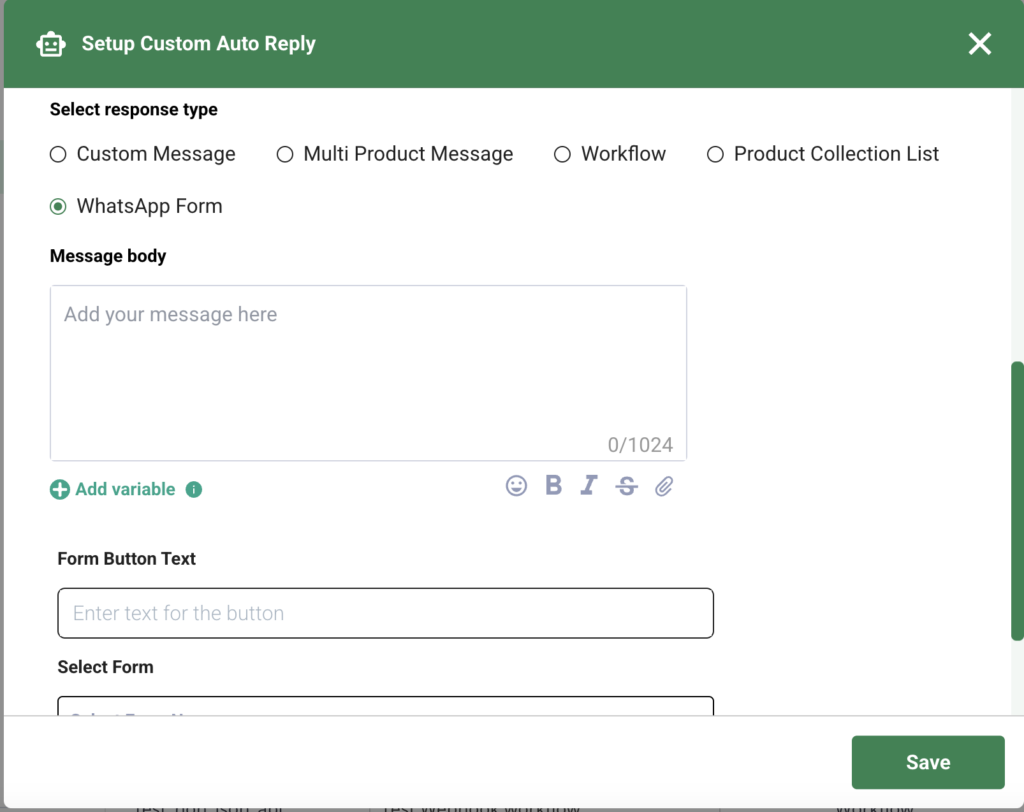
5. Workflows – Use WhatsApp Forms within workflows, with the ability to map responses to User Traits or Workflow variables for more personalized automation.
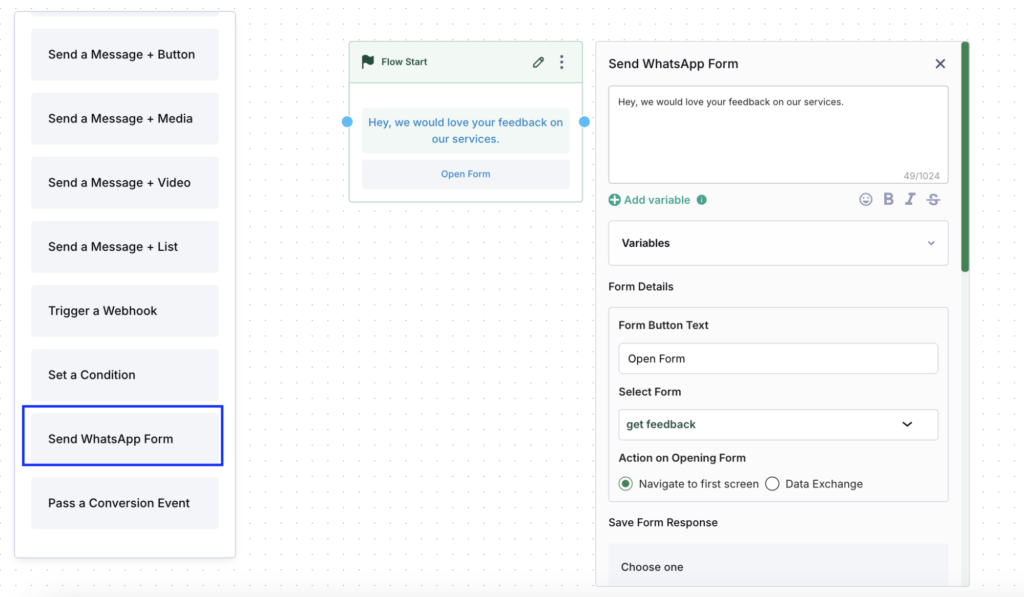
Additionally, merchants can access all their WhatsApp Forms from the ‘WhatsApp Forms’ page within the Automations section. From here, responses can be exported as a CSV, enabling easy data analysis and integration with other business tools.
Best practices for setting up WhatsApp Flows
By now we have established the effectiveness and benefits of WhatsApp Flows. But to realize them, you need to know how to perfectly implement them and follow the best practices and guidelines.
Clearly define objectives
Before setting up the WhatsApp flow, be sure to identify the specific goals you want to achieve with WhatsApp, to guide the design of your flow. This clarity is important to ensure that each step in the flow aligns with your goals and objectives.
Keep the screens balanced and clean
Ideally, stick to providing one task per screen, as too many tasks can overwhelm the users. For flows that require the user to complete multiple tasks, have the tasks split over several screens. Also, try to minimize the number of components on the screens as this can impact the loading time.
Reduce latency
Try to reduce latency by reducing the number of calls to third-party platforms and using async calls. You can also prevent re-fetching of unchanged data by caching the unchanged data.
Use Call To Action Button
Include clear call-to-actions that convey what the next task will be or what task will be completed on each screen. This helps customers clearly understand what they are expected to do and removes any confusion.
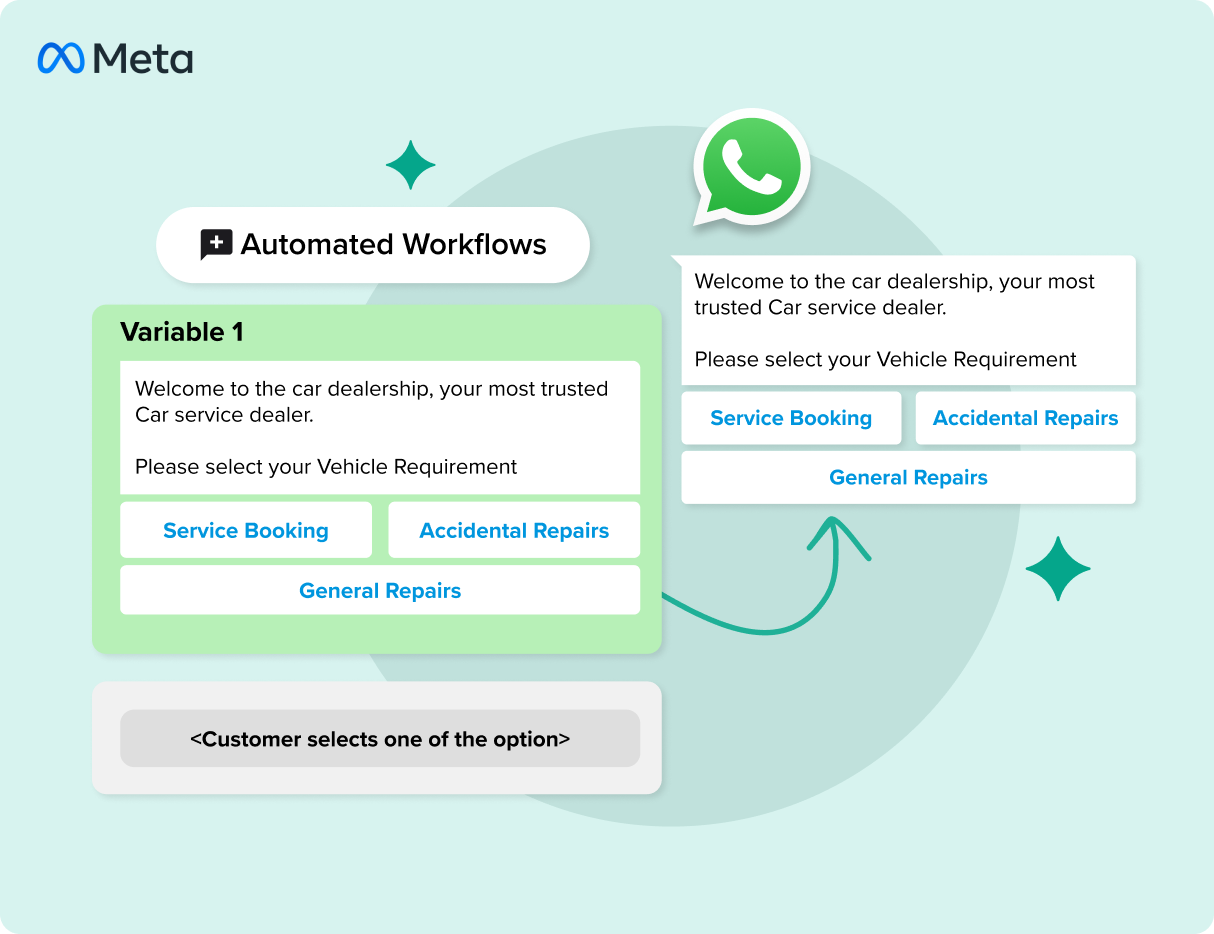
Handle errors well
When customers face an error when filling out information, this needs to be clearly conveyed, along with the information on what is wrong and how to resolve it. Validation rules need to be clearly conveyed to users to help them avoid these errors.
Use emojis wisely
The use of emojis should be justified by the context. When using them ensure that they are appropriate and fit well with the personality of the business.
Ensure form quality
For forms, always use the most relevant and appropriate components for each specific action. This involves using the text area component where a lot of text input is required or using the date picker for when a date needs to be provided.
Test and optimize regularly
Regularly test and optimize your flow after it is live. By monitoring performance and regularly making adjustments, you can greatly improve the flows for better results.
Provide clear exit points
Provide users with an easy way to exit the flow if they no longer wish to continue. This can be achieved by giving precise directions on how to end the conversation or by presenting an “exit” option at different stages of the flow. Allowing users to have control over the interactions is also important to prevent frustration.
How to measure the success of WhatsApp flow?
After setting up your WhatsApp Flows, you need to make sure that they are performing the way you want them to perform. You can measure the success of your WhatsApp Flows by tracking these four metrics:
Engagement rate
For a better understanding of how your WhatsApp Flows are performing, track your customer engagement rates. This will provide insights into what sort of flow content works with your customers, allowing you to make necessary adjustments to keep them engaged and promote interactions.
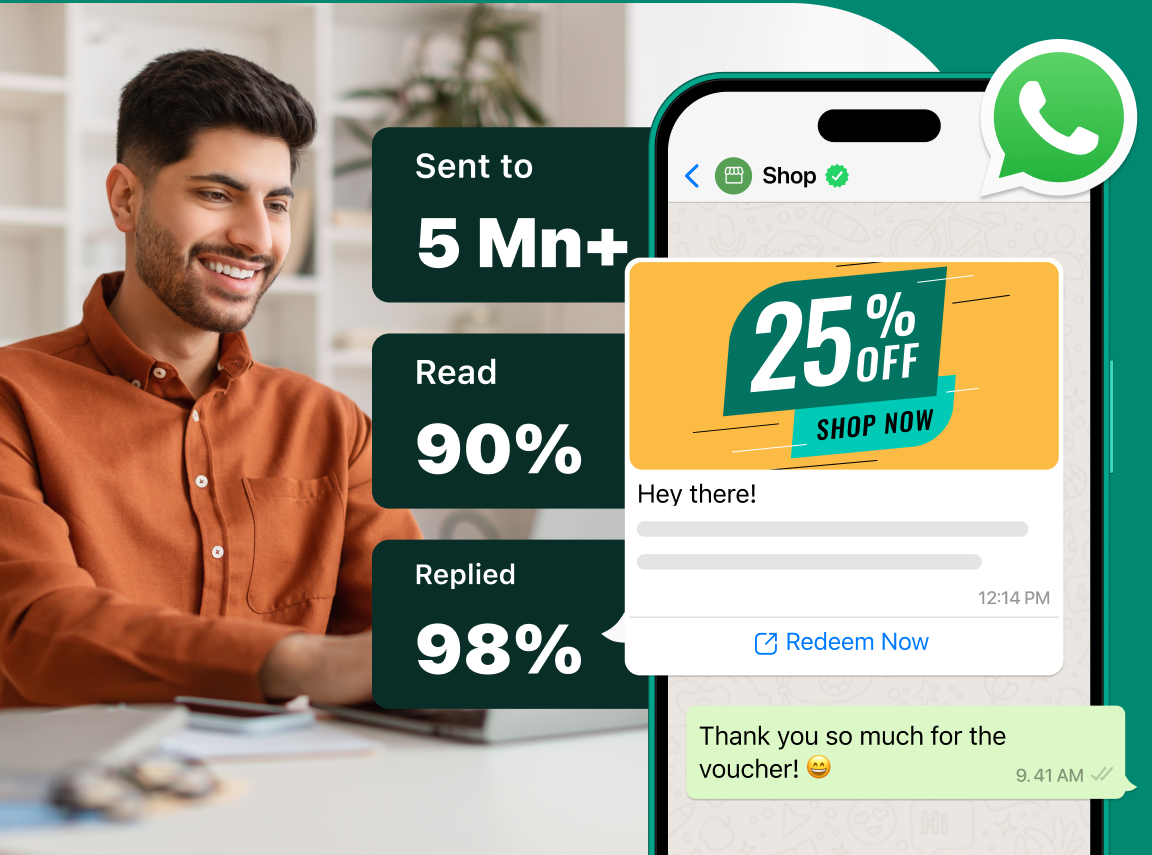
Customer satisfaction
Run surveys and request feedback to measure customer satisfaction. Your WhatsApp Flows are only successful if they can provide customers with a satisfactory experience that meets their expectations.
Hence, tracking the customer satisfaction score from your WhatsApp Flows is important to accurately understand how well your flows are performing.
Response times
Run surveys and request feedback to measure customer satisfaction. Your WhatsApp Flows are only successful if they can provide customers with a satisfactory experience that meets their expectations.
Hence, tracking the customer satisfaction score from your WhatsApp Flows is important to accurately understand how well your flows are performing.
Conversion rate
Run surveys and request feedback to measure customer satisfaction. Your WhatsApp Flows are only successful if they can provide customers with a satisfactory experience that meets their expectations.
Hence, tracking the customer satisfaction score from your WhatsApp Flows is important to accurately understand how well your flows are performing.
Summing up
WhatsApp Flows can significantly enhance the way you carry out optimized customer interactions and streamline operations on a platform that’s both familiar to most customers and widely accessible.
WhatsApp Flows can greatly help businesses increase customer satisfaction by automating interactions and offering unique and engaging experiences, while optimizing important tasks across departments, such as customer support, lead generation, and order processing.
And with a tool like Interakt, leveraging WhatsApp Flows and implementing them in the most ideal way, becomes increasingly easier.
Interakt lets you seamlessly create conversational flows to drive your clients through a variety of processes, like registering as a new student or a new user, making appointments, generating leads, collecting documents, and more.
Ready for efficient, streamlined and impactful business communication? Its time to start with Interakt’s WhatsApp flow builder.

